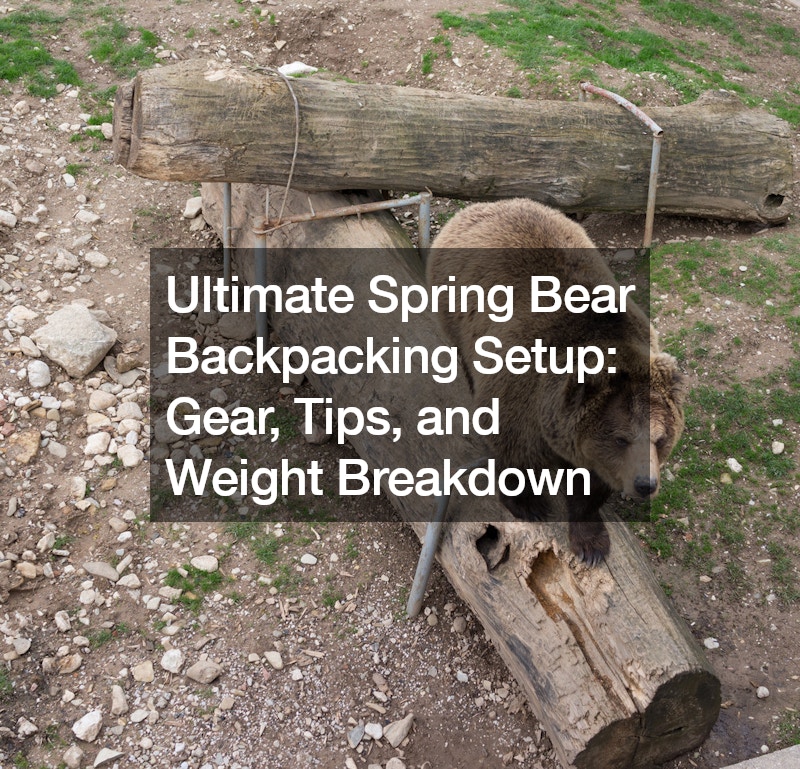Ultimate Spring Bear Backpacking Setup: Gear, Tips, and Weight Breakdown

Springtime in the backcountry of Idaho marks the beginning of an exciting season for bear hunters and outdoor enthusiasts alike. As nature awakens from its winter slumber, it’s time to gear up and embark on unforgettable adventures in pursuit of elusive bears.
Whether you’re an experienced backpacker or a novice explorer, bringing the right gear and preparing for the adventure ahead is essential for an enjoyable trip. This guide will delve into the ultimate spring bear backpacking setup, covering essential gear, valuable tips, and a detailed weight breakdown to help you plan your wilderness expedition with confidence.
Gear Essentials
- Traditional Bow: For hunters, a lightweight traditional bow is the weapon of choice for spring bear hunts. Opting for a fire-hardened hickory self-bow ensures reliability and performance in rugged terrain.
- Quality Binoculars: A good pair of binoculars is indispensable for spotting bears from a distance. Choose high-quality optics like the Vortex Razor UHDs to enhance your scouting and tracking capabilities.
- Hunting Knife: A reliable hunting knife is essential for field dressing and processing game during your spring bear hunt. Choose a durable blade with a comfortable grip, such as the Argali knife series, to ensure efficient and precise cutting in the field.
- Clothing: Dressing in layers with merino wool is key to staying comfortable and protected in varying weather conditions. Pack mid-weight hoodies, wool shirts, and waterproof outer layers like the Helly Hansen Impertec for rain or snow.
- Sleeping Gear: Invest in a quality sleeping bag rated for cold temperatures, such as the Mountain Hardwear Phantom Zero Degree Bag, to ensure restful nights in the wilderness. Pair it with a lightweight sleeping pad like the Therm-a-Rest NeoAir for added insulation and comfort.
- Food and Cooking: Plan your meals carefully for a seven-day backpacking trip, opting for lightweight and nutritious options like dehydrated meals and freeze-dried snacks. Don’t forget essential cooking gear like the MSR PocketRocket stove and fuel canisters for hot meals on the go.
- Safety and Communication: Prioritize safety with essential gear like an inReach Mini satellite communicator for emergency communication and GPS tracking. Carry basic first aid supplies, including leukotape for blister prevention, and a reliable headlamp for navigating in low-light conditions.
Filming Equipment: If documenting your adventure, opt for lightweight filming equipment like the GoPro Hero 10 for capturing high-quality footage without adding excessive weight to your pack. Pack extra batteries and memory cards for extended recording sessions.
Valuable Tips
Pack Light, Pack Smart
Minimize pack weight by prioritizing lightweight and multi-purpose gear, such as the Vargo titanium bot for water storage and cooking, alongside a hunting backpack with frame for efficient load distribution.
Efficient Gear Organization
Employ efficient gear organization techniques to maximize space and accessibility in your hunting backpack. Packing cubes or compression sacks can compartmentalize clothing, gear, and supplies, allowing easy access to essential items while minimizing clutter and maximizing pack space.
Stay Hydrated
Ensure an adequate water supply by carrying a combination of water bottles and a collapsible water reservoir. Plan water refills strategically along your route and consider water purification methods for safe drinking water from natural sources.
Mindful Footwear
Choose sturdy and supportive hiking boots like the Schnee’s Timberlines for navigating rough terrain and unpredictable weather. Pair them with moisture-wicking wool socks for blister prevention and foot comfort throughout your journey.
Leave No Trace
Practice Leave No Trace principles by minimizing environmental impact and respecting wildlife habitats. Pack out all trash, dispose of waste properly, and tread lightly to preserve the natural beauty of the wilderness for future generations.
Emergency Preparedness
Prioritize emergency preparedness by carrying essential safety and survival gear, including a lightweight emergency shelter, fire-starting tools, and a comprehensive first aid kit. Familiarize yourself with basic wilderness survival skills, such as navigation techniques and signaling methods, to mitigate risks and respond effectively to unforeseen challenges or emergencies in the backcountry.
Weight Breakdown
After carefully selecting and packing essential gear for your spring bear backpacking trip, it’s crucial to consider the overall weight of your pack. Aim for a balanced load that prioritizes comfort and functionality while minimizing unnecessary bulk. With meticulous planning and organization, achieve a manageable pack weight of around 26.5 pounds, excluding water, for a seven-day excursion into the backcountry.
The Bottom Line
The ultimate spring bear backpacking setup encompasses a combination of quality gear, strategic planning, and wilderness know-how. By equipping yourself with the right tools and knowledge, go on a memorable adventure filled with breathtaking scenery, thrilling encounters, and the exhilaration of exploring the great outdoors. Prepare, pack, and enjoy the journey ahead, knowing that you’re fully equipped for whatever the wilderness may bring.
.

